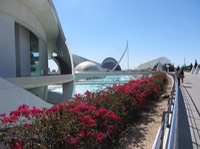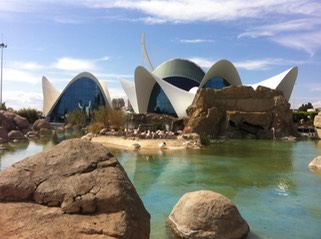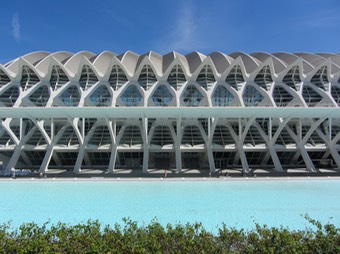
Only very special architects become eponymous with cities where they have held significant influence:- Robert Adam's Bath, Gaudi's Barcelona, Mackintosh's Glasgow, Haussmann's Paris. Even in a generation of spin it is unusual for contemporary architects to be identified with one city. Yet Calatrava's Valencia acknowledges both his birthplace and his huge contribution in creating a world class destination.
Following flooding (1957) the River Turia was diverted around Valencia. The river bed quickly formed a tranquil garden. In 1989 Joan Lerma, President of the Principality championed a local Professor's idea to create a "city of arts and sciences" within this river basin.
In the mid 1970's Town Planning was still the second degree of choice for most graduate architects. Santiago Calatrava preferred to follow his studies with a course in engineering in Switzerland. This denotes his scientific interest but Calatrava is also a committed and capable architect artist, painter and sculptor. His profound understanding of engineering, mathematics, sculpture and art has brought renowned for creating uncompromisingly modern buildings -often with anatomical derivations.
Calatrava's sinuous communication tower at Barcelona Olympics was applauded In 1992, and in the same year he achieved acclaim in north America for the cathedral like ‘Allen Lambert Galleria’ in Toronto. International recognition made him an obvious choice as architect for Valencia's audacious regeneration plan.

Working with Felix Candela on 'L’Oceanografic' a dynamic contrast to the historic City became immediately obvious. Deep tanks and landscaped lakes are well suited to the dried out river bed site. Like an iceberg most of the volume lies below the surface. Delicate hyperbolic paraboloid roofs, soaring curves and a lacy geodesic dome announce surface zones and entrances to the substantial subterranean facilities.
The complex opened in 1998 with “L’Hemisferic” - a real eye opener. Glazed side walls open like eye lids revealing a central spherical IMAX theatre. The adjacent white ribbed Science Museum provides vast bright exhibition halls and educational spaces on many levels. Cleverly concealed coach and car parking is contained beneath the elegant open "Umbracle". This soaring structure was designed for indigenous plants and sculptures - including one by Yoko Ono - as an attractive public promenade. It is now closed off as a 'disco' venue - presumably generating income.

Throughout the site serene blue lagoons compliment spectacular structures giving photo-friendly viewpoints everywhere. An otherworldly appearance conceals extremely refined design and circulation. Buildings and landscape effortlessly handle huge numbers of visitors without stress. Grinning groups record themselves with phones held high - or low - against this surreal and exciting place.
Architects armed with intellectual justifications for unpopular modernist buildings have no place here. This architecture - and architect - is popular and appreciated by all ages. Children see buildings with ears - and snouts, teenagers enjoy space to rumble, adults find serenity even contemplation amid a charismatic architectural environment.